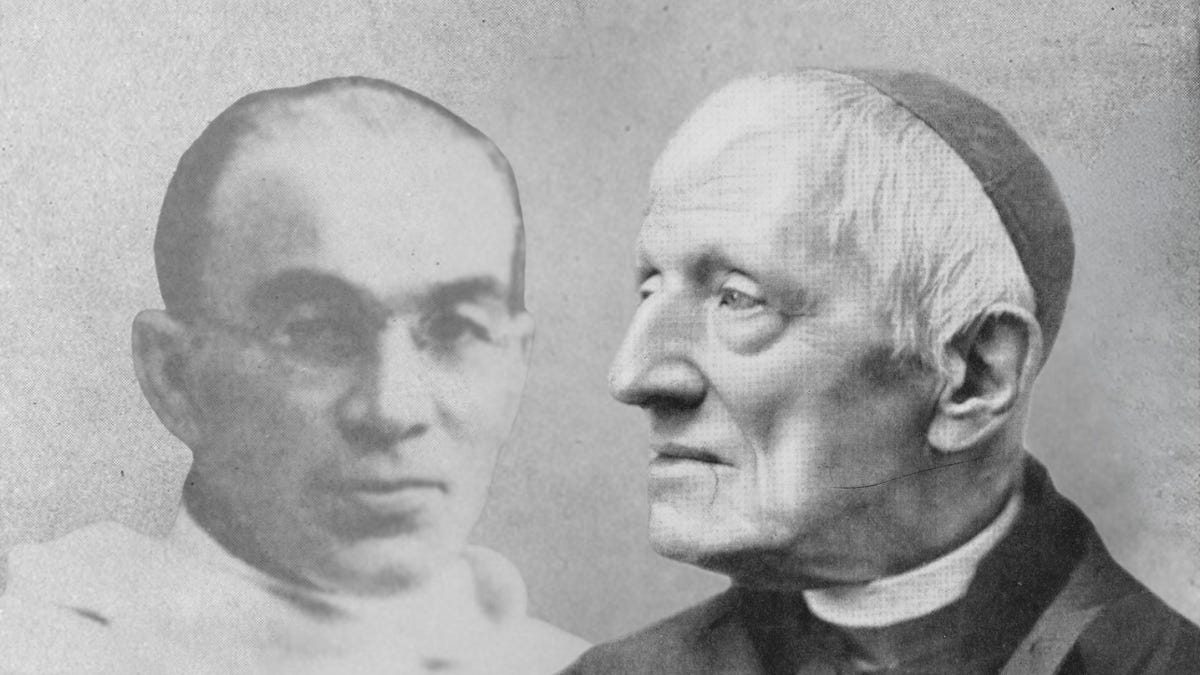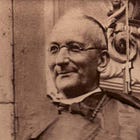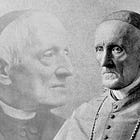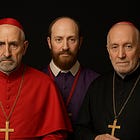Fr Marín-Sola OP on Cardinal Newman's orthodoxy
Rather than condemning Newman, this rigorous Thomist affirms, critiques, corrects and complements his work, bringing it into a scholastic framework – and warmly praising him throughout.

Rather than condemning Newman, this rigorous Thomist affirms, critiques, corrects and complements his work, bringing it into a scholastic framework – and warmly praising him throughout.
Introduction
In this article, we shall provide a survey of Fr Francisco Marín-Sola OP’s engagement with the writings of Cardinal John Henry Newman in his landmark work The Homogeneous Evolution of Catholic Dogma.
Marín-Sola (1873–1932) was a Spanish Dominican priest, philosopher, and theologian, known as “the Wise Marín.” Born in Cárcar, Navarra, he entered the Dominican Order in 1888 and studied philosophy and theology at Ocaña and Ávila. After his ordination in Manila in 1897, he was briefly imprisoned during the Tagalog insurrection (the Philippine Revolution) before beginning a distinguished academic career.
He taught mathematics and philosophy at the College of San Juan de Letrán and theology at the University of Santo Tomás in Manila, later serving in Spain, the United States, and Switzerland. From 1919 to 1927 he held the chair of dogmatic theology at the University of Fribourg, succeeding Norberto del Prado.
His most influential work, La evolución homogénea del dogma católico (1923), explored the legitimate development of Catholic doctrine in continuity with tradition. It is considered to be one of the best and most thorough accounts of the subject, within a rigorous Thomistic framework. As such, his perspective on Newman’s treatment of the subject (both in the Essay on the Development of Christian Doctrine and in other works) is of much greater value than some of more shallow critiques (or apologiae) found online today.
Marín-Sola received an honorary doctorate in civil law from the University of Notre Dame, and later served as a consultant to the Archbishop of New Orleans.
He returned to Manila in 1929, where he taught until his death in 1932.
Newman treated as one of the great writers
In the section titled ‘Historical Examples of Dogmatic Evolution Through Speculative Channels,’ Marín-Sola gives a series of examples of “true dogmatic developments after the time of the apostles, which were effected through the speculative channel of reasoning in the proper sense of this term.”1
In each example, he presents syllogisms in which the major premise is of faith, and the minor of reason – along with “testimonies of theologians of the first order who have thus understood them.”2 He concludes that taken together, these examples “will produce in any unprejudiced theologian the conviction that the evolution of dogma by way of theological conclusion is not only possible but an obvious historical fact accepted by all the great theologians.”3
The third example he gives is as “that in Jesus Christ there existed not only two natures, but also two wills and two different operations.”4 He explains:
“This was and is a revealed truth. But where and how was it revealed? It was revealed in two other truths in which it is implicit and from which it is inferred through reasoning. These truths are: first, “Jesus Christ is not only a true man but also a perfect man, or in a connatural state, or like us in everything except sin or anything opposed to the end of redemption”; second, “no one can be a perfect man, or man in a connatural state, or man like us in everything, without a human will and the other physico-natural powers or properties (although one can be truly or essentially man without them)”.
This reasoning, one of whose premises is of faith and the other of natural reason, has been the human instrument employed by the Church under the Holy Spirit’s assistance to uncover and define the dogma of the two wills in Christ.5
Who are the “theologians of the first order” whom he cites in support of this point?
St Thomas Aquinas
Bañez
St Robert Bellarmine.
He continues:
“We could continue quoting a great number of classical theologians in the line of traditional theology, but we would simply be repeating texts similar to those already quoted in other sections. We will, therefore, limit ourselves to three illustrious modern theologians: one a Thomist, the other belonging to Suárez’s school, the third independent of any school.”6
The “illustrious modern theologians” cited, as further examples of “theologians of the first order,” are:
Fr Joachim Berthier OP
Cardinal Franzelin
Cardinal Newman.
Let us now consider how Marín-Sola refers to Newman and treats his writing in this section.
Newman treated with respect, even where Marín-Sola offers criticism
Marín-Sola approaches Newman not only with caution, but also with warm praise. Nor is this praise only for his person: he particularly praises his writings in general, and the Essay on the Development of Catholic Doctrine and its presentation of the subject.
“Let the third be the, on so many counts, illustrious Cardinal Newman, the modern theologian who had the clearest vision of the existence of dogmatic progress.
“In his brilliant work, An Essay on the Development of Catholic Doctrine, written while he was still a Protestant – it was in the course of writing this work that he became a convert – Newman perhaps gave excessive importance to sense, life, experience, praxis, as instruments in the development of Catholic dogma while taking little or almost no account of reasoning, which he seems to regard with the same dislike as our objector.”7
He immediately answers his own criticism, with reference to the role of inference (viz. the process of reasoning) in Newman’s Catholic writings:
“Any man whose reading of Newman is limited to this work, knows him only partially, and will at times be inclined to find in Newman a way of speaking akin to Modernism. But his subsequent years as a Catholic enabled Newman to see more deeply into the great problem of dogmatic development, with the result that instead of giving little or no importance to the role played by reasoning in this matter, he seems at times to overrate it, or rather he gives it the importance that it deserves, that which St. Thomas and the great masters of Scholasticism always accorded it.
“Thus, in his famous conferences at the Catholic University of Dublin, a good many years after his conversion, he writes the following: ‘Revelation is all in all the doctrine; the Apostles its sole depositary; the inferential method its sole instrument; and ecclesiastical authority, its sole sanction.’
“Still many years later, with regard to the dogma of the two wills in Christ, Newman wrote: ‘The sixth Council condemned the doctrine that there is but one energeia in Christ, which is condemned neither by Scripture, except by inference, nor by tradition.’”8
Thus, this section shows Marín-Sola treating Newman with great respect, and ranking him with undoubtedly great theologians; both praising and giving appropriate qualification to Newman’s Essay, and dismissing any parallels between his writing and modernism as being a feature of his Anglican period.
Marín-Sola returns to this praise later in the work, when he considers “whether dogmatic evolution by way of assimilation is possible.” While he denies that it is, and explicitly opposes Newman in so doing, let us consider the manner in which he does so:
“The difference between the development of physical life and the development of intellectual life
“Ever since Cardinal Newman wrote his brilliant Essay on the Development of Christian Doctrine, there is mention, even by Catholic writers, of assimilation as one of the channels of dogmatic development. In our opinion no such assimilation exists, not only in dogma, but not even in the sciences. All that is being written to the contrary comes from extrapolating the laws and material processes of vegetable and animal life, in the proper sense of the terms, to the spiritual life of the intellect.”9
He proves the orthodoxy of Newman’s thought, even when he disagrees with the use of terms
After expounding his reasoning for rejecting this use of terms, with reference to St Thomas, he returns to Newman:
“215. Cardinal Newman’s genuine thought
“The learned Cardinal Newman speaks of the process of assimilation because he is dealing with the development not only of doctrine but also of the rites and discipline and the other things accidental to Christianity. Such things are ordinarily external things, which admit not only assimilation but also transformation, as a man transforms his clothing or his nourishment without transforming his specific nature.
“Truth to say, by ‘additions’ or ‘assimilations’, in the matter of doctrines, Newman means exactly the same thing that traditional theology designates with the terms ‘unfolding’ or ‘explication’ of the implicit virtuality. Newman maintained during his whole life the habit of calling ‘additions’ or ‘assimilations’ everything that was not ‘explicit’ from the beginning. However, there are times in which he expresses himself so clearly, that there can be no doubt as to what he meant by such terms.
“In 1849, four years after his conversion, Newman expressed his thinking in the following manner: ‘It is well known, though the creed of the Church has been one and the same from the beginning, yet it has been so deeply lodged in her bosom as to be held by individuals more or less implicitly instead of being delivered from the first in those special statements, or what are called definitions, under which it is now presented to us, and which preclude mistake or ignorance. These definitions which are but the expression of portions of the one dogma which has ever been received by the Church, are the work of time; they have grown to their present shape and number in the course of eighteen centuries, under the exigency of successive events, such as heresies and the like, and they may of course receive still further additions as time goes on.’ (Difficulties of Anglicans)
“Twenty-five years after his conversion he wrote Dr. White: ‘The time may come when it will be seen how those traditions are compatible with additions, that is, with true developments, which those traditions indeed do not explicitly teach.’10
Marín-Sola then refers to several works, including the Anglican work Essays Critical and Historical, which was republished with Newman’s Catholic commentary on what he had previously written:
“His Essays Critical and Historical, published in 1871, contain the following: ‘The hypothesis about the depositum fidei in which I gradually acquiesced was that of doctrinal development, or the evolution of doctrines out of certain original and fixed dogmatic truths, which were held inviolate from first to last, and the more firmly established and illustrated by the very process of enlargement.’ And Newman immediately subjoins that when he wrote of “new shapes foreign to each other’” (in the book’s first edition) he was borrowing the language of a theory that was not his own: ‘Whereas here I have given utterance to a theory, not mine, of a certain metamorphosis and recasting of doctrines into new shapes — “in nova mutatas corpora formas” – Those old and new shapes being foreign to each other, and connected only as symbolizing or realizing certain immutable but nebulous principles.’
“Here is a new text, which is no less interesting. It is found in Newman’s conferences on the Difficulties of Anglicans: ‘To the Apostles the whole revelation was given, by the Church it is transmitted; no simply new truth has been given to us since St. John’s death; the one office of the Church is to guard “that noble deposit” of truth, as St. Paul speaks to Timothy, which the Apostles bequeathed to her, in its fullness and integrity.’
“Let us, finally, recall the terms in which Newman delivers his thinking on the development of dogma: ‘Revelation is everything in Catholic doctrine, the Apostles its sole depositary; the inferential method its sole instrument; and ecclesiastical authority, its sole sanction.” (Idea of a University)
“In his celebrated Essay on the Development of Christian Doctrine, Newman determines seven marks or characteristics of the legitimate or homogeneous development. In the third place he names the ‘power of assimilation,’ and in the sixth place the ‘preservative additions’, but he expressly requires that these truths, which he calls assimilations or additions, should not be opposed to the revealed datum, whether by excess or by defect (as happens in the case of every contrary concept), nor even totally unconnected with, or foreign to, it (as happens in the case of every diverse concept), but that there truly be affinity between them and the revealed datum, which is precisely what the great schoolmen termed concordant (consona) concepts or mutually implicit concepts (n. 20). As a matter of fact, there can be no affinity between ideas without an internal connexion; if that connexion is absolute or metaphysical, the so-called affinity is nothing other than true implicit identity (n. 247), in which case that which in physiological language both psychologists and Newman call assimilation or addition, is, in the truly philosophical and theological language of the School, no more than a true explication of what is implicit. That is also the meaning given by Newman to his phrase ‘new dogmas’, that is to say, not objectively new, but explicitly new.”11
Marín-Sola rejects the association of Newman with modernists
Having expounded Newman’s “genuine thought,” Marín-Sola proceeds to discuss the “grave injustice” of associating Newman with modernism.
“Hence, we believe that Newman has been the victim of a grave injustice, not only on the part of the Modernists who pretend to see in him a forerunner of their doctrines, but also on the part of certain Catholic theologians who believe that Newman’s ideas on the evolution of dogma are not thoroughly consistent with Catholic teaching merely on account of the fact that his peculiar phraseology in this matter is rather different from that commonly employed by scholastic theologians.* His Holiness Pius X has rightly said of Newman: ‘Indeed, nothing is found in the great abundance of his [Newman’s] works that seems foreign to the common teaching of theologians: nothing that can cast suspicion on his faith.’”12
At this point, Marín-Sola appends the following footnote:
* “Today no one is unaware that Newman was for a long time viewed with suspicion. But, if I were allowed to speak of skill in such matters as these, where only absolute sincerity is admissible, I would say that nothing is more groundless and more unjust than this suspicious attitude towards one of the most Catholic spirits that have ever existed.” (BREMOND, HENRY: Newman, ed. 8, Paris 1908, Introd., pgs. 10-11)
However, it must be admitted that there are some very weak points in his philosophy, e.g., his theory on the origin of knowledge and on the nature of certainty. But this has nothing, or almost nothing, to do with his theological theory on the origin and nature of dogmatic evolution.13
Marín-Sola’s choice to cite Henry Bremond’s Newman (1908) is curious. Bremond moved in the French modernist milieu and wrote at a time when many of its members claimed Newman as one of their own, interpreting his historical and psychological method as a justification of modernism itself. To the modernist mind, the “Catholic spirit” was presumably simply the modernist spirit under another name. As such, it is not clear whether Marín-Sola intended this quotation of Bremond as a vindication of Newman (which does not seem to work) or as an example of one of “the Modernists who pretend to see in him a forerunner of their doctrines.”
Marín-Sola’s frank commentary on Catholics reading Newman’s Anglican works
Marín-Sola continues, giving his frank views on the shortcomings of some of Newman’s works, whilst avoiding the excessive zeal of some of his modern critics:
“We believe that Newman’s ideas on the evolution of dogma are not only perfectly orthodox, but also thoroughly traditional at bottom; however, his theologico-philosophical vocabulary is at times as poor and deficient as his psychological observations and his historical synthesis of dogmatic evolution are unfailingly rich and penetrating. His immortal book An Essay on the Development of Christian Doctrine – Newman began it while still an Anglican, and became a convert to Catholicism while working on it – embodies, in our view, the clearest view of the nature and development of the Catholic Church that is possible to one who is outside but so close that it is almost touching her.
“Newman’s book is like the bridge through which one passes from Anglicanism to Catholicism; this constitutes its great merit. But, by the same token, it is also the bridge through which one can, either through carelessness or mistake, pass from Catholicism to Anglicanism or Modernism; this constitutes its possible danger. To approach this conception of the Catholic Church as seen from the outside, which Newman offers in his book, is, for a Catholic, to approach the extreme confines wherein Catholicism borders on Protestantism, whereas, for a Protestant, it is to approach the extreme confines where Protestantism borders on Catholicism.”14
This point should not be construed as a criticism; it accords with the stated purpose for which Newman’s Essay was published with ecclesiastical approval. Newman can hardly be faulted for that.
While respecting Marín-Sola’s view, we should also point out that it was not the view of Fr Giovanni Perrone SJ or Fr Giacomo Mazio SJ, two Jesuits at Rome who praised the work and quoted it at length in their own works.15
Marín-Sola continues with this balanced criticism:
“This is why we usually refrain from indifferently advising any Catholic young man to read this and certain other works of Newman unless he possesses solid philosophico-theological grounding, and yet we would advise – as we have always advised – any Protestant or agnostic to read, and read frequently, this and all of Newman’s other works, in the persuasion that his writings will do more to attract them to Catholicism than all other theological and philosophical apologias written by the greatest Catholic theologians and metaphysicians, but with a rather speculative and intellectual tenor.”16
Marín-Sola’s final absolution from heterodoxy
Following this balanced criticism, Marín-Sola ends with an absolution from any heterodox conception of “transformist evolution” in doctrine:
“We believe that if the illustrious Newman had been as great a theologian or philosopher as he was a psychologist and historian, he could have written one of the best apologias for the Catholic religion that could be dreamt of.
“But he himself realized, and was not ashamed of owning it, that he was not a good theologian and had no hopes of being one. In February of 1869, he wrote to Sister Maria Pia: ‘Really and truly I am not a theologian... I am not, and never shall be.’
“This lack of theology, or rather of precision in theological nomenclature, accounts for Newman’s use of the terms additions or assimilations with respect to dogma, despite the fact that in his own mind such terms signify nothing else but homogeneous developments or explications of what was already contained in the primitive datum virtually, but truly implicitly. This is the only evolution possible in dogma. To speak of additions or assimilations in any other sense would not be homogeneous or explicative, but transformist, evolution.”17
Conclusion: Marín-Sola repeats the vindication, and compares Newman with Bossuet
This survey has shown us the great respect which Marín-Sola brought to his engagement with Newman’s work. He took great care to speak positively about Newman’s person and his writings, even when he disagreed with them. He applied to these works the supposition of St Ignatius:
“Every good Christian is more eager to justify than to condemn a statement of his neighbour; and if he cannot justify it, he asks the author for an explanation. If the author explains it ill, he corrects him with charity; and when that is not enough, he endeavours to the best of his power to find an acceptable meaning which will save the proposition.”18
His vindication of Newman’s orthodoxy is also an edifying example of St Hilary’s principle, as quoted by St Thomas Aquinas:
“Hilary says (De Trin. iv): ‘The meaning of what is said is according to the motive for saying it: because things are not subject to speech, but speech to things.’ Therefore we should take account of the motive of the lawgiver, rather than of his very words.”19
Marín-Sola’s justification of the orthodoxy of Newman’s thought reappears later in the text, when he compares him with Bossuet, and explains how their apparently contradictory arguments are reconciled:
“In effect, no matter how many texts from the Fathers are compiled to prove that dogma is completely immutable, not one will be found that expresses the immutability of dogma in such seemingly absolute and rigid terms as that memorable phrase of Lérins: ‘Quod semper, quod ubique, quod ab omnibus’. And yet, the same hand that wrote those words, also wrote in the same book the words inchoate and unformed, and let it mature, grow, and come to perfection.
“As a matter of fact, immutability and development are not two opposed things, but two harmonious aspects and two complementary facets of the same thing, that is, of homogeneous evolution. Given immutability alone, that is, with no development, there would be no evolution, but no life either. Given development, but without substantial immutability, there would not be homogeneous evolution, but corruption or transformism. The union of both these characteristics makes for the true life of dogma. This is why both are present together in the Catholic Church, and both are found wanting in the heretical, and even in the schismatic sects.
“This explains why two Catholic apologists, as eminent as Bossuet and Newman, could have employed in defense of the Catholic Church arguments that seem contradictory. Bossuet said to Protestantism: ‘You change; therefore, the truth is not in you.’ To Anglicanism Newman said: ‘You admit no evolution’ therefore, you have no life.’ Truth to say, far from contradicting each other, these two aspects represent the two properties that characterize the truth when it is deposited in human minds and hearts to give life both to the individual and the society.
“It explains why all those sects that have separated themselves from the vital principle, which is the divine magisterium of the Catholic Church, are wanting in either one or the other of these two essential properties of life. Either they lack the characteristic of substantial immutability because they have abandoned dogmas that are truly primitive, or they lack the characteristic of vital progress because they have restricted their belief to the dogmas defined up to such a century or such a council and have rejected any development that such dogmas have had or might have had in subsequent times or councils.
“These two fundamental properties of every living being find their parallels in two properties or states in every dead organism or corpse: either the unchangeable or rigid state of the mummy, or the dissolving state of corruption. The first is the state of immutability without progress; the second, the state of progress without immutability. The former is the state of the heretical or schismatic sects of the East; the latter is the state of the Protestant sects of the West.
“Hence, the formula of true dogmatic life, which Lérins gave us and the Vatican Council made its own, includes neither immutability alone nor progress alone, but includes substantial immutability together with vital or homogeneous progress: ‘Let it, then, grow ... but in the same sense.’”20
Overall, Marín-Sola positions himself as affirming, critiquing, correcting and complementing what is found in Newman’s work, and bringing its insights into a scholastic framework – rather than condemning it.
Such treatment – both that which is simply positive and that which is critical – could provide Newman’s critics with a new and superior model of how to pursue their subject.
HELP KEEP THE WM REVIEW ONLINE WITH WM+!
As we expand The WM Review we would like to keep providing free articles for everyone.
Our work takes a lot of time and effort to produce. If you have benefitted from it please do consider supporting us financially.
A subscription gets you access to our exclusive WM+ material, and helps ensure that we can keep writing and sharing free material for all.
You can see what readers are saying over at our Testimonials page.
And you can visit The WM Review Shop for our ‘Lovely Mugs’ and more.
(We make our WM+ material freely available to clergy, priests and seminarians upon request. Please subscribe and reply to the email if this applies to you.)
Subscribe to WM+ now to make sure you always receive our material. Thank you!
Read Next:
Plus, some highlights:
Follow on Twitter, YouTube and Telegram:
Francisco Marín-Sola OP, The Homogeneous Evolution of Catholic Dogma, pp. 358. Trans. Antonio T. Piñon, Santo Tomas University Press, Manila Philippines, 1988.
Ibid. pp 358-9
Ibid. p. 359
Ibid. p. 364
Ibid. pp. 364-5.
Ibid. p. 365
Ibid. p. 367
Ibid.
Ibid. p. 392
Ibid. p. 396-7
Ibid., pp. 397-8
Ibid. pp. 398-9
Ibid. p. 399
Ibid. p. 399
Giacomo Mazio, “Liturgia Anglicana,” Annali delle Scienze Religiose, 2.5.13 ( July–August 1847): 50–160; 2.5.14 (September–October 1847): 181–292.
Giovanni Perrone, “Della denominazione che la Chiesa Cattolica dà alle comunioni da lei divise di eretiche e di scismatiche,” Annali delle Scienze Religiose, 2.6.17 (March–April 1848): 215–21.
Marín-Sola, p. 399
Ibid. p. 400
St. Ignatius, Spiritual Exercises, Presupposition, n. 22.
St Thomas Aquinas, Ia IIae, Q96, A6.
Marín-Sola, p. 644-5







